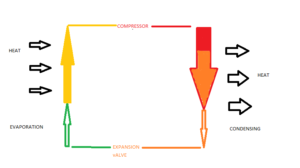What is a Heat Pump and How Does it Work?
1stAssociated are Independent Surveyors who carry out Building Surveys sometimes known as Structural Surveys. Over the years of carrying out Surveys we have seen all sorts of properties and we have also noticed that people have become more interested in the thermal efficiency of their property. We use a thermal imaging camera to establish the thermal efficiency of buildings.

Overview
A heat pump is a mechanical device designed to extract heat from one place, and move it to another.
Refrigerators, freezers, cold rooms, and air conditioners are all examples of devices generally run by heat pumps.
Whilst most heat pumps are run by electricity, it is also possible to drive heat pumps mechanically such as with an engine powered by mains gas (quite a lot of large commercial heat pumps use gas engines), or in theory by a turning shaft driven by wind, water, or muscle power. Most vehicle air conditioning units are mechanically driven off the engine.
The operating principle of a heat pump is based on the following physical principle.
When a fixed quantity of gas is compressed into a smaller volume, it gets hotter as the pressure rises. Heat is allowed to dissipate via a heat sink or heating load, and the refrigerant gas condenses. The pressure is then released allowing the condensed refrigerant to expand back to gas at low pressure at which stage, the gas cools to below ambient temperature and is allowed to absorb heat serving a cooling load, or dumping cold to the environment. This same physical process of expanding gas cooling is responsible for the fact that air on a mountain top is colder than lower down the mountain.
For expert advice Free Phone 0800 298 5424
Heat Pump Cycle

This process for an ideal gas follows the following equation:
PV = nRT
Where:
P = Pressure
V= Volume
n = The amount of gas
R = a physical constant
T = Temperature
A heat pump employs a circuit on one side of which a compressor compresses a refrigerant gas, and on the other, the compressed gas is released.
On both sides of the heat pump there are heat exchangers used either to capture heat / cold for use providing a service or on the other side providing a sink to get rid of unwanted heat or cold.
“Work” is extracted by taking the heat from the compressing side to where heating is desired, or the cold from the expansion side to where cold is needed. In some cases, both sides of the heat pump can be used so that for example, a room might be cooled with the removed heat being used to produce hot water.
In practice, whilst all gases get hot when compressed, most gases are not ideal gases, and if you just use any gas – such as for example ambient air in a heat pump, you will end up with a heat pump which is not very efficient, so specialised gases known as refrigerant gases are employed in heat pumps.
With an optimised system, it is possible to deliver several times as much heat for each kWh of electricity used than with traditional resistive electrical heating. For this reason, technologies based on heat pumps are increasingly used in place of gas boilers and other combustion based heating solutions as with an increasingly clean electricity supply, they are associated with lower greenhouse gas emissions than either combustion based or electrical resistive heating.
Refrigerant Gases
A large number of gases can be used as refrigerant gases – with different gases being appropriate at different temperature ranges, and with a variety of factors needing to be optimised when selecting a refrigerant gas.
Global Warming Potential (GWP)
Many refrigerant gases if released to the atmosphere will have a warming effect on the climate. Refrigerant gases are scored on their GWP with a ratio to CO2. A gas with a GWP of 10 will have 10 times the climate impact of CO2
Some older now banned refrigerant gases had GWPs in the tens of thousands. In recent years, standards have been progressively tightened to reduce the allowable GWP of refrigerant gases so that any gas released to the atmosphere will have less impact on the climate.
Ozone Depletion
In addition to their climate impact, many of the older refrigerant gases had the effect of breaking down Ozone in cold conditions in the polar stratosphere – especially over Antarctica – leading to a substantial loss of stratospheric Ozone spreading to Southern Australasia and the south of Latin America. As Ozone acts as an ultraviolet filter, loss of Ozone in the stratosphere results in a greatly increased risk of skin damage and skin cancer in these regions, and adverse impacts on habitats in these regions.
The worst gases for Ozone depletion were banned and replaced with alternatives which are safer to the Ozone layer, and also had lower GWP.
Toxicity
Some gases with reasonably decent performance as refrigerant gases have toxicity issues. One such is ammonia which has a very unpleasant odour and is also toxic at high enough concentrations.
Ammonia is sometimes used as a refrigerant gas in large systems which can be monitored for leaks, but not in smaller domestic scale applications.
Flammability
Some refrigerant gases are highly flammable and or have potential to cause explosions such as Propane or chemically similar gases. These can be used with care, but only with suitable safety precautions.
Efficiency and Temperature Range
Different refrigerant gases vary in the degree to which they can deliver energy efficiency in a heat pump at a given operating temperature range. Different gases will be selected depending on temperature range – e.g. a 4 Centigrade cold room will use a different refrigerant to a system making liquid nitrogen.
Cost
Some possible refrigerants like CO2, Ammonia and Propane are cheap, whilst others cost far more.
Taking all of the above into account, a refrigerant gas is selected for a particular application, and the heat pump is optimised to operate efficiently using that refrigerant.
Independent Chartered Surveyors
If you want an independent expert opinion from a chartered building surveyor call 0800 298 5424. We carry out valuations, building surveys, structural surveys, structural reports, engineers reports, specific defects reports, home buyers reports or any other property matters.
Please contact us on Free Phone 0800 298 5424 to have a free of charge friendly chat with one of our chartered surveyors.
Commercial Property
If you are looking for commercial property, whether it is freehold or leasehold, we would recommend a survey as this will prevent dilapidations claims in the long run. You may wish to look at our Dilapidations Website at www.DilapsHelp.com and for Disputes go to our Disputes Help site www.DisputesHelp.com, both of which we have been advised are very helpful!
We hope you have found this article useful
We hope you found the article of use and if you have any experiences that you feel should be added to this article that would benefit others, or you feel that some of the information that we have put is wrong, then please do not hesitate to contact us (we are only human). For more information contact us on Free Phone 0800 298 5424.
The contents of the website are for general information only and is not intended to be relied upon for specific or general decisions. Appropriate independent professional advice should be paid for before making such a decision.
All rights are reserved, the contents of the website are not to be reproduced or transmitted in any form in whole or part without the express written permission of www.1stAssociated.co.uk.

